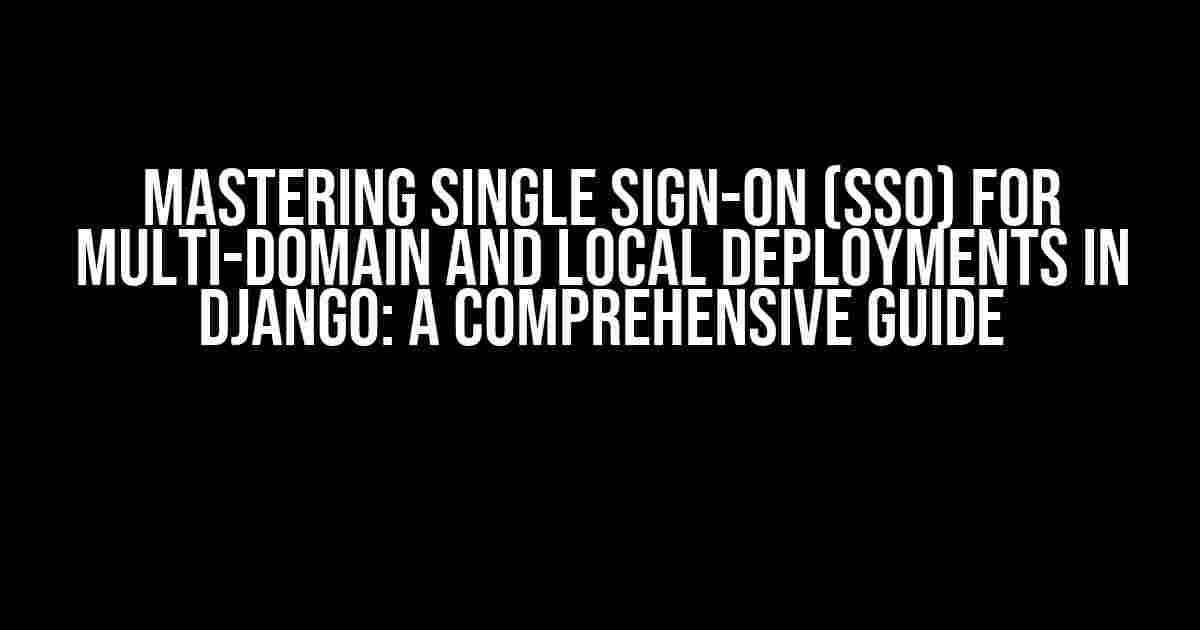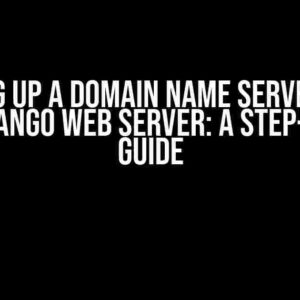Managing Single Sign-On (SSO) for multi-domain and local deployments can be a daunting task, especially when working with Django applications. However, with the right approach and tools, you can provide a seamless and secure user experience across multiple domains and environments. In this article, we’ll delve into the world of SSO and explore the best practices for implementing and managing SSO in Django applications.
What is Single Sign-On (SSO), and Why Do We Need It?
Single Sign-On is an authentication mechanism that allows users to access multiple applications or systems with a single set of login credentials. In other words, users only need to remember one username and password to access multiple services. SSO eliminates the need for users to remember multiple login credentials, reducing the risk of password fatigue and improving overall security.
The Benefits of SSO
- Improved user experience: SSO provides users with a seamless experience across multiple applications and domains.
- Increased security: SSO reduces the risk of password-related security breaches and provides an additional layer of security.
- Reduced administrative burden: SSO simplifies user management and reduces the administrative burden on IT teams.
- Enhanced scalability: SSO enables organizations to scale their applications and services more efficiently.
Django and SSO: Challenges and Opportunities
Django, being a popular Python web framework, provides a robust and scalable platform for building modern web applications. However, implementing SSO in Django can be challenging, especially when dealing with multi-domain and local deployments. In this section, we’ll explore the challenges and opportunities associated with Django and SSO.
Challenges
- Cookie domain restrictions: Django’s default cookie domain settings can limit SSO functionality across multiple domains.
- Session management: Managing user sessions across multiple domains and environments can be complex.
- Authentication and authorization: Integrating authentication and authorization mechanisms across multiple domains and applications can be daunting.
Opportunities
- Django’s built-in authentication and authorization system: Django provides a robust authentication and authorization system that can be leveraged for SSO.
- Third-party libraries and tools: Django’s ecosystem offers a range of third-party libraries and tools that simplify SSO implementation.
- Customizability: Django’s modular design allows for customization and extensibility, making it easier to implement SSO solutions.
Implementing SSO in Django: A Step-by-Step Guide
In this section, we’ll provide a step-by-step guide on how to implement SSO in Django for multi-domain and local deployments.
Step 1: Configure Django’s Authentication and Authorization System
Django’s built-in authentication and authorization system provides a solid foundation for SSO implementation. To configure Django’s authentication and authorization system, follow these steps:
# settings.py
AUTH_USER_MODEL = 'myapp.MyUser'
AUTHENTICATION_BACKENDS = [
'django.contrib.auth.backends.ModelBackend',
]
MIDDLEWARE = [
'django.contrib.sessions.middleware.SessionMiddleware',
'django.contrib.auth.middleware.AuthenticationMiddleware',
]
Step 2: Install and Configure a Third-Party SSO Library
There are several third-party libraries available for Django that simplify SSO implementation. For this example, we’ll use the ‘django-sso’ library. Install the library using pip:
pip install django-sso
Then, add the ‘django-sso’ app to your Django project’s INSTALLED_APPS:
# settings.py
INSTALLED_APPS = [
# ...
'django_sso',
]
Step 3: Configure SSO for Multi-Domain Deployments
To enable SSO across multiple domains, you’ll need to configure Django’s session management and cookie domain settings. In your settings.py file, add the following configuration:
# settings.py SESSION_COOKIE_DOMAIN = '.example.com' # Replace with your domain SESSION_COOKIE_AGE = 31536000 # 1 year SSO_DOMAIN = 'auth.example.com' # Replace with your SSO domain SSO_KEY = 'your_secret_key' # Replace with your secret key
Step 4: Implement SSO Logic in Your Views
In your views, you’ll need to implement the SSO logic to authenticate and authorize users. Here’s an example:
# views.py
from django_sso.views import sso_login, sso_logout
def login_view(request):
return sso_login(request, next_url='/')
def logout_view(request):
return sso_logout(request, next_url='/')
Best Practices for Managing SSO in Django
Implementing SSO in Django requires careful planning and management. Here are some best practices to keep in mind:
Use a Centralized Authentication Server
Using a centralized authentication server simplifies SSO management and reduces the risk of security breaches.
Implement Session Management
Implementing session management ensures that user sessions are properly managed across multiple domains and environments.
Use Secure Cookies
Using secure cookies (HTTPS) ensures that user credentials are protected during transmission.
Monitor and Audit SSO Activity
Monitoring and auditing SSO activity helps detect and respond to security breaches and user authentication issues.
Conclusion
Implementing SSO in Django for multi-domain and local deployments requires careful planning, configuration, and management. By following the steps outlined in this article, you can provide a seamless and secure user experience across multiple domains and environments. Remember to follow best practices, such as using a centralized authentication server, implementing session management, using secure cookies, and monitoring and auditing SSO activity. With the right approach, you can master SSO in Django and provide a superior user experience.
| Domain | SSO Configuration |
|---|---|
| example.com | SESSION_COOKIE_DOMAIN = ‘.example.com’ |
| subdomain.example.com | SESSION_COOKIE_DOMAIN = ‘.example.com’ |
| local.dev | SESSION_COOKIE_DOMAIN = ‘local.dev’ |
Note: This article is for informational purposes only and should not be considered as professional advice. Always consult with a qualified professional before implementing SSO solutions in your Django application.
By following the instructions outlined in this article, you can successfully implement SSO in your Django application and provide a seamless and secure user experience across multiple domains and environments. Happy coding!
Frequently Asked Question
When it comes to managing SSO for multi-domain and local deployments in a Django application, there are several questions that come to mind. Here are some answers to get you started:
What are the benefits of implementing SSO in a multi-domain Django application?
Implementing SSO in a multi-domain Django application provides a seamless user experience, reduces password fatigue, and increases security. With SSO, users only need to authenticate once to access multiple domains, making it more convenient and efficient. Additionally, SSO simplifies user management for administrators, as they only need to manage a single set of credentials.
How do I configure SSO for local deployments in Django?
To configure SSO for local deployments in Django, you can use the built-in authentication system and implement a custom authentication backend. You can also use third-party libraries like Django-SSO or PySAML2 to simplify the process. Additionally, you can use environment variables or configuration files to set up SSO for local deployments.
What are some common challenges when implementing SSO for multi-domain Django applications?
Some common challenges when implementing SSO for multi-domain Django applications include handling different domains, subdomains, and protocols, managing sessions and cookies, and dealing with cross-site scripting (XSS) and cross-site request forgery (CSRF) attacks. Additionally, ensuring SSO compatibility with different browsers and devices can be a challenge.
How do I handle session management in a multi-domain SSO setup with Django?
To handle session management in a multi-domain SSO setup with Django, you can use a centralized session store, such as Redis or Memcached, to store and manage sessions across multiple domains. You can also use a library like Django-Sessions to simplify session management. Additionally, you can implement a custom session management system using Django’s built-in session framework.
What are some best practices for securing SSO in a multi-domain Django application?
Some best practices for securing SSO in a multi-domain Django application include using secure protocols, such as HTTPS, implementing secure session management, using strong authentication and authorization mechanisms, and monitoring and logging SSO-related activities. Additionally, regularly testing and reviewing SSO configuration and implementation can help identify and address potential security vulnerabilities.


